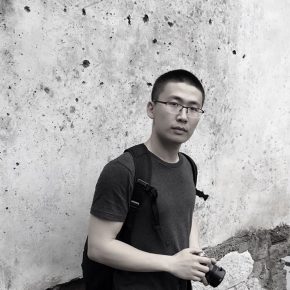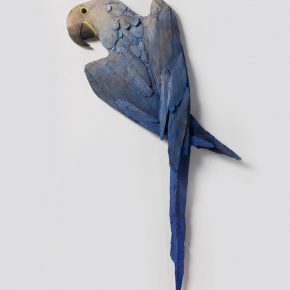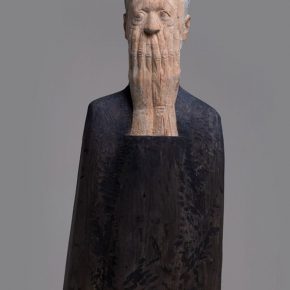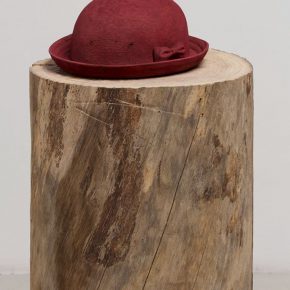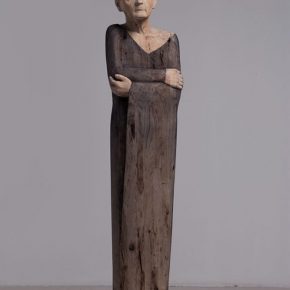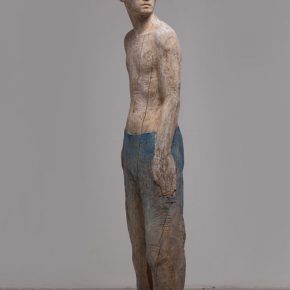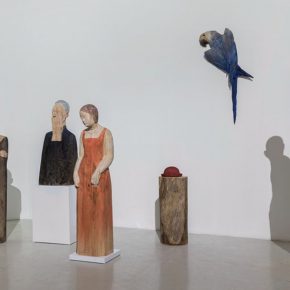
Born in Chengde City in Hebei Province 1988, Wang Mingze graduated from CAFA in 2017, with a master’s degree. In 2007, he was admitted to the CAFA to study in the specialty of sculpture. In 2014, he became a postgraduate student of the Department of Sculpture, CAFA, he was engaged in the research of the sculptural modeling language, learning from Wang Wei. Wang Mingze’s work “Station” is a group of sculpture works in camphor wood, which is currently on show at the CAFA Art Museum.
Interview Time: May 22, 2017
Interviewee: Wang Mingze (hereinafter referred to as Wang)
Interviewer: Zhong Yuwei (hereinafter referred to as CAFA ART INFO)
Editor: Lin Jiabin
Translated by Chen Peihua and edited by Sue/CAFA ART INFO
“I love wood, the simplicity corresponds with humankind: cracks and growth patterns are almost unavoidable, remaining as traces in the creative process, like the strokes on the surface of the sculpture. I hope to use the tactile sense of the rough texture of wood, accompanied by the traces created by cutting or tearing the creation, revealing the spirituality of the life of wood and the texture that is close to people. Experiencing the process of the game between material and human with the passage of time.
– Wang Mingze
CAFA ART INFO: Both the name of the “Station” series and the name of the single sculpture, are full of modern poetic qualities and stories, so that people can’t help but be curious about the moments of the story in this group of works. Can you talk about the story of your work?Wang: When I created these things I did not think of a whole story, and the group of sculptural works is composed of each single story brought together to form a mutual echo of a story, which I never expected. But when I finished this group of works, I considered the whole theme, and I wanted to convey the authentic moment.
CAFA ART INFO: Where is the inspiration of the overall consideration of this group of works from?Wang: In particular, I prefer to capture the moment, and showcase instantaneous dynamics of people or things, while the human emotions and mind are not camouflaged and it is the most real in this instantaneous moment. But I hope through an instant dynamic to convey an eternal spirit and emotion of people, the idea of the overall work including the name, starts from this consideration. Each work performs an instantaneous action, such as a surprise, tension, moment of glancing back …
CAFA ART INFO: Do you want the viewer to feel the subject of eternity and moments in your work? Do you hope the viewer has other interactions with yourwork?Wang: One thousand readers lead to one thousand Hamlets, for example, some people are sad when they look at my work, while some people have a feeling of expectation when they look at my work, which is the self-examination of the audience. But I did not specifically want to convey an emotion. I hope to, through the work, help people feel life and inspect themselves …
CAFA ART INFO: Seen from the perspective of iconology, it represents a certain connotation and meaning behind the visual elements of works. There is a parrot, hat, and 3 characters with different facial expressions, being surprised or slightly cold, in the work. Why did you choose these images?Wang: The majority of my works neither have a real image reference, nor specially use an element to tell a story, but these things are captured when they appear in the moments of my life and creation. Many viewers give me feedback on the interpretation of the story, which is what I pursue to some extent. The audience can make a self-examination when he looks at it, and create their own story, to achieve the expression of life and self-spirit of people using other materials.
For the connotation conveyed by the work “Station”, Wang Mingze said: “Station is a state, both the moments full of story telling for people or things, and the process of stopping to repeatedly scrutinize the process of production. During the length of the creation and groping with the wood, I try my best to turn my feelings into concrete shapes or images in order to convey the true feelings in the instantaneous fragments of life.”
CAFA ART INFO: What was your state when you were engaged in the graduation creation?Wang: I started to create this group of works when I was a second-year graduate student, but I was under a lot of pressure when I was engaged in the graduation creation because I have to deal with many things when I graduate; in addition, wood carving is a long operation rather than quickly finishing it, working and stopping were alternated, which made me very confused.
CAFA ART INFO: Did you encounter difficulties? How did you overcome them?Wang: It was indeed a difficulty, which was deeper than the technical difficulty, I thought of how to make this group of works better. Working for a long time made me felt numb, so I stopped and considered how I could make my emotions become precipitated, and seizing the emotions that were to be expressed. I need a long time to observe and then create. For example, in the work of “The Corner that Has Never Been Forgotten”, her toes were not originally buckled as is the current form, which I applied because I hope to express her anxiety. It is also a process of scrutiny.
CAFA ART INFO: You have studied in the Department of Sculpture, CAFA since you were an undergraduate student, what is the biggest change in art creation that you have witnessed during this decade?
Wang: I studied in the First Studio of the Department of Sculpture, CAFA, when Iwere an undergraduate student, in the past 10 years my teachers have always been stressing the “shape”, so I think I have made great progress in the shaping of sculpture. Compaed with the creation of the undergraduate, I have a fuller understanding of emotions and the world, in addition to the level of shaping.
CAFA ART INFO: You have graduated twice from CAFA, do you have a plan after graduation? If you want to continue on the path of artistic creation, what isyour goal?Wang: After graduation, I will definitely keep creating. I have a deep feelings of wood, and I hope to find a breakthrough in the shaping expression in wood. In addition, wood is such a traditional material that I am always thinking of how to combine it with contemporary art.
Photo courtesy of the artist.


